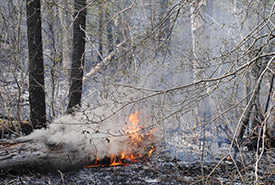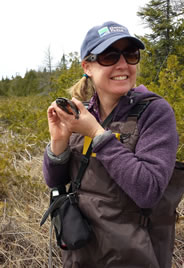The force of fire on the Rice Lake Plains

Prescribed burn on Hazel Bird property, Rice Lake Plains, ON (Photo by NCC)
Wildfires cause a lot of destruction each summer. There are dramatic videos and pictures in the news every year. So why did the Rice Lake Plains Joint Initiative (RLPJI) partner organizations purposely light several fires this spring?
In some parts of Ontario fires used to be a common, natural part of the landscape. Some ecosystems and species need fire in order to survive and are now disappearing from the province. The Rice Lake Plains Joint Initiative, Ministry of Natural Resources and Forestry, Nature Conservancy of Canada (NCC) and many other non-government organizations are dedicated to understanding the role of fire in Ontario, and to using fire to restore unique communities of plants and animals.
That’s why RLPJI partner Ontario Parks conducts prescribed burns in some provincial parks, including the Burnley-Carmel addition to Peter’s Woods Provincial Nature Reserve (near Cobourg). We co-manage this site with NCC, who purchased the land to protect its special fire-adapted ecosystems. Most of our prescribed burns are “low-intensity,” meaning that the flames stay close to the ground and the slow-moving flame front is easy to control. This kind of fire kills young trees and shrubs that are growing into areas that would naturally be more open, but full-grown trees survive. It also prepares the soil for rare native wildflowers and grasses to grow.
Prescribed burns are a completely different beast from wildfires. There are months of planning that go into making sure that nothing goes wrong. In fact, after the first few minutes it’s not even exciting to watch anymore!
This spring we were very happy to burn a section of Peter’s Woods that we’ve been planning to burn for several years. Each year RLPJI partners plan burns across the Rice Lake Plains area, but we have to wait for the perfect mix of rainfall, wind, temperature and humidity to get the conditions we need to be successful. If it is too wet, cool, or humid the fire will fizzle out and won’t do the job. If it is too dry, warm or windy the fire will be too difficult to control.
Goldilocks’ problems were a piece of cake in comparison!
Despite a late spring with quite unpredictable weather, on May 26 everything was “just right” and specially trained Ontario Parks and NCC staff burned eight acres (just over three hectares) of forest at Peter’s Woods. This section of forest has large black oak trees, and unusual shrubs and flowers like fragrant sumac and wild bergamot — all species typical of the oak savannahs that dominated this area when European settlers (like Catharine Parr Traill) first arrived.
The fire did an excellent job of killing the young maples and cherries that were starting to creep in and change the ecosystem. We will monitor the site to see what plants and birds make their homes in this restored area.


